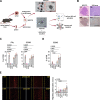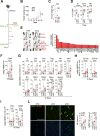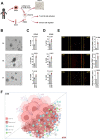Combined mitoxantrone and anti-TGFβ treatment with PD-1 blockade enhances antitumor immunity by remodelling the tumor immune landscape in neuroblastoma
- PMID: 36397148
- PMCID: PMC9670422
- DOI: 10.1186/s13046-022-02525-9
Combined mitoxantrone and anti-TGFβ treatment with PD-1 blockade enhances antitumor immunity by remodelling the tumor immune landscape in neuroblastoma
Abstract
Background: Poor infiltration of functioning T cells renders tumors unresponsive to checkpoint-blocking immunotherapies. Here, we identified a combinatorial in situ immunomodulation strategy based on the administration of selected immunogenic drugs and immunotherapy to sensitize poorly T-cell-infiltrated neuroblastoma (NB) to the host antitumor immune response.
Methods: 975A2 and 9464D NB cell lines derived from spontaneous tumors of TH-MYCN transgenic mice were employed to study drug combinations able of enhancing the antitumor immune response using in vivo and ex vivo approaches. Migration of immune cells towards drug-treated murine-derived organotypic tumor spheroids (MDOTS) were assessed by microfluidic devices. Activation status of immune cells co-cultured with drug-treated MDOTS was evaluated by flow cytometry analysis. The effect of drug treatment on the immune content of subcutaneous or orthotopic tumors was comprehensively analyzed by flow-cytometry, immunohistochemistry and multiplex immunofluorescence. The chemokine array assay was used to detect soluble factors released into the tumor microenvironment. Patient-derived organotypic tumor spheroids (PDOTS) were generated from human NB specimens. Migration and activation status of autologous immune cells to drug-treated PDOTS were performed.
Results: We found that treatment with low-doses of mitoxantrone (MTX) recalled immune cells and promoted CD8+ T and NK cell activation in MDOTS when combined with TGFβ and PD-1 blockade. This combined immunotherapy strategy curbed NB growth resulting in the enrichment of a variety of both lymphoid and myeloid immune cells, especially intratumoral dendritic cells (DC) and IFNγ- and granzyme B-expressing CD8+ T cells and NK cells. A concomitant production of inflammatory chemokines involved in remodelling the tumor immune landscape was also detected. Interestingly, this treatment induced immune cell recruitment against PDOTS and activation of CD8+ T cells and NK cells.
Conclusions: Combined treatment with low-dose of MTX and anti-TGFβ treatment with PD-1 blockade improves antitumor immunity by remodelling the tumor immune landscape and overcoming the immunosuppressive microenvironment of aggressive NB.
Keywords: Drug Evaluation; Immunomodulation; Immunotherapy; Neuroblastoma; Tumor Microenvironment.
© 2022. The Author(s).
Conflict of interest statement
The authors declare that they have no competing interests.
Figures







Similar articles
-
Combining ERAP1 silencing and entinostat therapy to overcome resistance to cancer immunotherapy in neuroblastoma.J Exp Clin Cancer Res. 2024 Oct 22;43(1):292. doi: 10.1186/s13046-024-03180-y. J Exp Clin Cancer Res. 2024. PMID: 39438988 Free PMC article.
-
Immunogenic Cell Death Inducers in Cancer Immunotherapy to Turn Cold Tumors into Hot Tumors.Int J Mol Sci. 2025 Feb 14;26(4):1613. doi: 10.3390/ijms26041613. Int J Mol Sci. 2025. PMID: 40004078 Free PMC article.
-
PD-L1-expressing natural killer cells predict favorable prognosis and response to PD-1/PD-L1 blockade in neuroblastoma.Oncoimmunology. 2023 Dec 1;13(1):2289738. doi: 10.1080/2162402X.2023.2289738. eCollection 2024. Oncoimmunology. 2023. PMID: 38125723 Free PMC article.
-
Immune checkpoint molecules in neuroblastoma: A clinical perspective.Semin Cancer Biol. 2022 Nov;86(Pt 2):247-258. doi: 10.1016/j.semcancer.2022.06.013. Epub 2022 Jul 3. Semin Cancer Biol. 2022. PMID: 35787940 Review.
-
T cells in the microenvironment of solid pediatric tumors: the case of neuroblastoma.Front Immunol. 2025 Feb 28;16:1544137. doi: 10.3389/fimmu.2025.1544137. eCollection 2025. Front Immunol. 2025. PMID: 40092980 Free PMC article. Review.
Cited by
-
The neuroblastoma tumor microenvironment: From an in-depth characterization towards novel therapies.EJC Paediatr Oncol. 2024 Jun;3:100161. doi: 10.1016/j.ejcped.2024.100161. Epub 2024 Apr 7. EJC Paediatr Oncol. 2024. PMID: 39036648 Free PMC article.
-
Inhibition of autophagy enhances the antitumor efficacy of T/CAR T cell against neuroblastoma.J Exp Clin Cancer Res. 2025 Jul 3;44(1):185. doi: 10.1186/s13046-025-03453-0. J Exp Clin Cancer Res. 2025. PMID: 40611330 Free PMC article.
-
Evaluation of a Combinatorial Immunotherapy Regimen That Can Cure Mice Bearing MYCN-Driven High-Risk Neuroblastoma That Resists Current Clinical Therapy.J Clin Med. 2024 Apr 26;13(9):2561. doi: 10.3390/jcm13092561. J Clin Med. 2024. PMID: 38731089 Free PMC article.
-
Two bullets in the gun: combining immunotherapy with chemotherapy to defeat neuroblastoma by targeting adrenergic-mesenchymal plasticity.Front Immunol. 2023 Oct 2;14:1268645. doi: 10.3389/fimmu.2023.1268645. eCollection 2023. Front Immunol. 2023. PMID: 37849756 Free PMC article. Review.
-
Monocyte and Macrophage in Neuroblastoma: Blocking Their Pro-Tumoral Functions and Strengthening Their Crosstalk with Natural Killer Cells.Cells. 2023 Mar 13;12(6):885. doi: 10.3390/cells12060885. Cells. 2023. PMID: 36980226 Free PMC article. Review.
References
-
- Melaiu O, Lucarini V, Giovannoni R, Fruci D, Gemignani F. News on immune checkpoint inhibitors as immunotherapy strategies in adult and pediatric solid tumors. Semin Cancer Biol. 2020;79:18–43. - PubMed
-
- Wolchok JD. Checkpoint blockade: the end of the beginning. Nat Rev Immunol. 2021;21(10):621. - PubMed
MeSH terms
Substances
LinkOut - more resources
Full Text Sources
Medical
Research Materials

